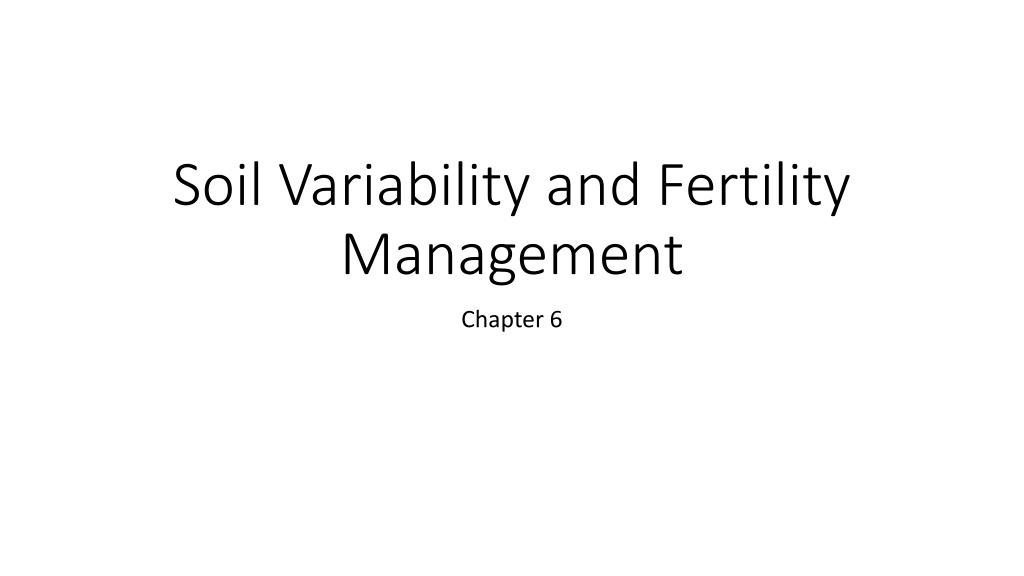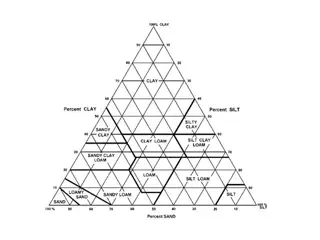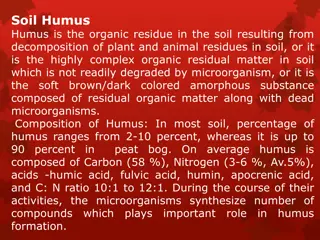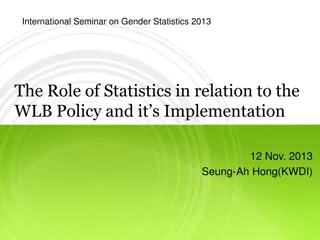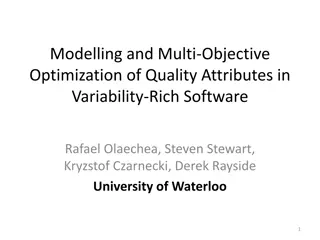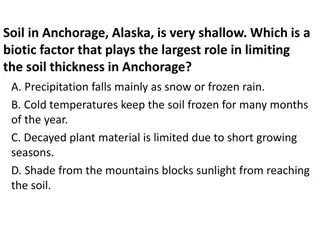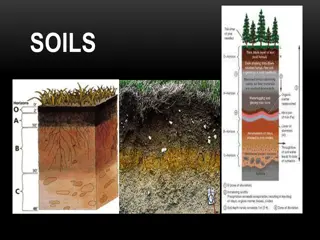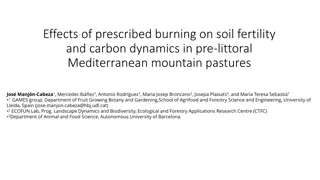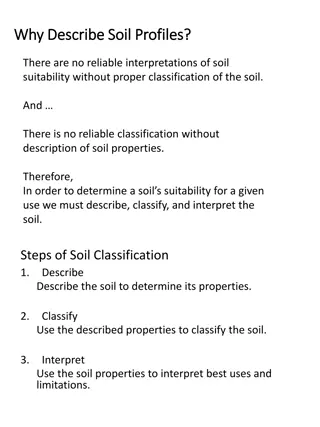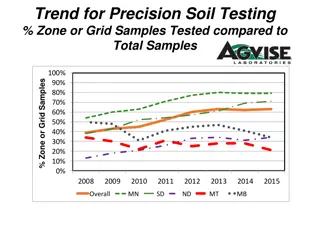Soil Variability and Fertility Management
Addressing challenges in crop production involves managing soil nutrients, moisture content, and variability. Precision agriculture techniques offer solutions such as site-specific nutrient management and mathematical approaches for matching fertilizer recommendations. This chapter discusses sources of soil variability and tools to aid growers in managing it effectively.
Download Presentation

Please find below an Image/Link to download the presentation.
The content on the website is provided AS IS for your information and personal use only. It may not be sold, licensed, or shared on other websites without obtaining consent from the author.If you encounter any issues during the download, it is possible that the publisher has removed the file from their server.
You are allowed to download the files provided on this website for personal or commercial use, subject to the condition that they are used lawfully. All files are the property of their respective owners.
The content on the website is provided AS IS for your information and personal use only. It may not be sold, licensed, or shared on other websites without obtaining consent from the author.
E N D
Presentation Transcript
Soil Variability and Fertility Management Chapter 6
Among the numerous challenges of crop production is the management of soil nutrients, soil moisture content and crop and soil variability. One of the first problems that was addressed in precision agriculture was site-specific nutrient management (Pierce and Nowak, 1999). Since then, advancements have been made in the creation of mathematical approaches that can be used to help match fertilizer recommendations to soil and crop productivity. This chapter will review sources of soil variability and current management tools and techniques to help growers manage soil variability.
Sources of Soil Variability Sources of Soil Variability Variability can result from many factors, including those from inherent differences produced during soil development, the result of erosion following tillage, and systematic errors from uneven application of fertilizers and manures (Franzen, 2011). Variability is discussed in more detail in Chapter 2 (Kitchen and Clay, 2018).
General Soil Sampling General Soil Sampling Basics Basics Soil sampling is variable in three dimensions There is two-dimensional variability that is most often considered: forward, backward, and side to side. But there is also vertical variability. Tillage and lack there-of complicates the Vertical. Banding, No matter depth highly complicates Horizontal. Starter for row crops complicates less.
Watkins et al. Minimum of 10 years in a no-till management system.
Watkins et al. Stratification of Soil Phosphorus Avg. 9 site years Stratification of Soil pH Avg. 9 site years P conc. (mg P / kg soil) soil pH 0.00 20.00 40.00 60.00 80.00 4.00 5.00 6.00 7.00 8.00 0 0 5.08 A 5.08 A soil sampling depth (cm) soil sampling depth (cm) 10.16 B 10.16 A pre_P pH 15.24 C 15.24 B 20.32 20.32 25.4 25.4 30.48 C 30.48 D 35.56 35.56
9 On farm No-till Wheat P Response Studies Watkins et al. 100 0-5 cm 5-10 cm 10-15 cm 15-30 cm Range in M3P (ppm) 80 60 40 20 0 1 2 3 4 5 6 7 8 9 Location Sampling Depth cm 0 -5 5 -10 10 -15 15 -30 Mehlich III Extractable P Min Max Mg P kg-1 2.2 41.1 2.9 43.3 2.3 12.7 1.5 5.3 Soil pH Max Year Location Ave Min Ave 11.8 7.3 4.9 2.7 5.9 6.3 6.2 6.6 8.1 8.2 5.2 9.1 6.9 7.3 7.3 7.8 2014 Stillwater
Sampling in Banded Fields. Fig. 6.1. Sampling strategy for soil P and K in a transect perpendicular to row direction spanning at least one complete row. Sample depth could be 6 to 8 inches depending on the sampling depth basis of regional, state, province or state P and K recommendations.
How we Do Nitrogen Corn Option 1: Well, ___________ (fill in name) did it this way. Option 2: What did __________ (fill in name of guy down the road that grows good corn) do?
*Optimum N rate kg ha-1 Source Location Years Time period (0-N) Yield Range High N Yield Range ---- Mg ha-1 ---- 1.6-7.6 2.7-5.6 0.8-5.9 1.4-6.2 6.6-10.9 5.5-7.3 1.7-5.6 3.2-7.4 3.8-8.2 6.2-11.3 5.6-10.2 2.1-7.4 1.9-9.5 3.1-4.9 1.9-6.1 3.3-5.6 4.5-7.2 5.0-6.0 2.1-6.4 2.7-4.4 6.2-8.9 5.0-8.9 1.8-2.6 2.7-4.2 6.4-7.9 2.7-7.4 Min 50 58 81 134 73 5 70 60 23 0 66 35 0 102 69 99 45 90 11 59 69 13 127 36 182 51 62 44 Max 233 235 237 239 193 131 113 199 126 37 111 230 203 178 204 194 182 117 218 116 96 114 233 196 204 160 173 55 Avg. 130 179 165 197 131 84 91 135 69 18 91 128 98 144 124 153 103 104 104 88 83 75 183 142 193 105 120 43 SD 53 51 49 32 49 69 21 50 36 15 23 46 52 30 47 49 71 20 88 40 13 54 45 75 15 77 45 20 Bundy et al. (2011) Bundy et al. (2011) Mallarino and Torres (2006) Mallarino and Torres (2006) Varvel et al. (2007) Jokela et al. (1989) Carroll Jokela et al. (1989) Webster Fenster et al. (1976) Waseca Fenster et al. (1976) Martin A Fenster et al. (1976) Martin B Al Kaisi et al. (2003) Ismail et al. (1994) NT Ismail et al. (1994) CT Rice et al. (1986) NT Rice et al. (1986) CT Stecker et al. (1993) Columbia Stecker et al. (1993) Novelty Stecker et al. (1993) Corning Peterson et al. (1989) Eck (1982) Shapiro et al. (2006) RS 51cm Shapiro et al. (2006) RS 76cm Meisinger et al. (1985) MT Meisinger et al. (1985) PT Gehl et al. (2005) Rossville Gehl et al. (2005) Scandia WI WI IA IA NE MN MN MN MN MN CO KY KY KY KY MO MO MO NE TX NE NE MD MD KS KS 21 9 20 14 5 3 3 5 7 6 3 20 20 15 15 3 3 2 4 2 3 3 4 4 2 2 1958-1983 1984-1997 1979-2003 1985-2010 1995-2005 1982-1984 1982-1984 1970-1975 1970-1976 1971-1976 1998-2000 1998-2000 1970-1990 1970-1985 1970-1985 1988-1990 1988-1990 1989-1990 1983-1986 1977-1978 1996-1998 1996-1998 1974-1977 1974-1977 2001-2002 2001-2002 4.3-8.8 5.7-9.96 5.1-12.4 5.3-12.8 10.4-13.3 7.1-9.1 1.8-8.7 7.1-10.6 4.0-9.6 6.2-12.0 8.3-10.8 5.2-10.9 3.5-10.4 5.7-9.2 5.0-8.8 6.0-10.1 6.7-9.9 8.2-8.5 3.9-10.0 5.6-5.9 9.4-11.1 7.1-11.0 5.8-8.2 5.1-8.1 11.3-12.6 3.8-11.5 Average SD Total 198
Nitrogen in the Crop - EONR *Optimum N rate kg ha-1 Max 239 193 131 113 199 126 37 96 114 204 160 Location Years Time period (0-N) Yield Range High N Yield Range ---- Mg ha-1 ---- Source Min 134 73 5 70 60 23 0 69 13 182 51 Avg. 197 131 84 91 135 69 18 83 75 193 105 SD 32 49 69 21 50 36 15 13 54 15 77 IA NE MN MN MN MN MN NE NE KS KS 14 5 3 3 5 7 6 3 3 2 2 1985-2010 1995-2005 1982-1984 1982-1984 1970-1975 1970-1976 1971-1976 1996-1998 1996-1998 2001-2002 2001-2002 1.4-6.2 6.6-10.9 5.5-7.3 1.7-5.6 3.2-7.4 3.8-8.2 6.2-11.3 6.2-8.9 5.0-8.9 6.4-7.9 2.7-7.4 5.3-12.8 10.4-13.3 7.1-9.1 1.8-8.7 7.1-10.6 4.0-9.6 6.2-12.0 9.4-11.1 7.1-11.0 11.3-12.6 3.8-11.5 Mallarino and Torres (2006) Varvel et al. (2007) Jokela et al. (1989) Carroll Jokela et al. (1989) Webster Fenster et al. (1976) Waseca Fenster et al. (1976) Martin A Fenster et al. (1976) Martin B Shapiro et al. (2006) RS 51cm Shapiro et al. (2006) RS 76cm Gehl et al. (2005) Rossville Gehl et al. (2005) Scandia
Nitrogen in the Crop - EONR 120 Yield (bu ac-1) Economical Opt N Rate 100 80 60 40 20 0 2004 2005 2006 2007 2008 2009 2010 2011 2012 2013 2014 2015 1.67 1.58 .51 .77 1.14 1.36 3.22 2.22 1.33 1.5 1.4 Average of 68 lbs with 49 BPA, 1.5 lbs N per bushel
Fine and Course Control Fine Control Making high resolution decisions using low resolution recs. Recommendation maps are at < 1 acre resolution and critical value that represents a whole state. How Precise is that. Course Control
Where is the opportunity N-Crop: Is the yield Temporally Variable? Spatially Variable? N-Soil: Do you have 2% OM and inconsistent weather? E-Fert - is your texture or landscape spatially variable? Can you adjust based on Management.
How we Do Phosphorus Soil Testing was the basis Determine immediately and potentially available P. Relate back to Correlation Calibration work. (50s-60s) Critical Values Est. 100 % Max Yld 0 10 Soil Test P (Bray P1 or Mehlich-3) 65
How we Do Phosphorus Recs Sufficiency program Feed the Plant Intended to estimate the long-term average amount of fertilizer P required to, on average, provide optimum economic return in the year of application. There is little consideration for future soil test values
How we Do Phosphorus Recs Build-Maintain (Replacement) Apply enough P to or K to build soil test values to a target soil test value over a planned timeframe (e.g. 4-8 years), then maintain based on crop removal and soil test levels NOT intended to provide optimum economic returns in a given year, but minimize the probability the P or K will limit crop yields while providing for near maximum yield potential Crop Harvest unit P in yield Corn Soybean Wheat Bushel Bushel Bushel .38 .8 .5
How we Do Phosphorus Recs Build-Maintain (Replacement) Sounds good and makes sense right. Build-up maintain fertilizer scheme suggested by the Ohio State University. If we are using this approach. Does rate matter. Nutrient response curve based on soil test, Rutgers Cooperative Extension.
Understanding Crop Response to Fertilizer Low Soil Test Levels Low yields without additional fertilizer EOR range is narrow Optimum rate is minimally affected by grain:nutrient price ratio L. Haag, Wheat U - 10 Aug 2016 Wichita
Understanding Crop Response to Fertilizer Medium Soil Test Levels Expected yield without fertilizer is higher Range of potentially optimal rates is wider In a single-year decision framework, EOR is very sensitive to grain:nutrient price ratio As price ratio EOR L. Haag, Wheat U - 10 Aug 2016 Wichita
Understanding Crop Response to Fertilizer High Soil Test Levels No or minimal response to added fertilizer L. Haag, Wheat U - 10 Aug 2016 Wichita
EXAMPLE OF THE RELATIONSHIP BETWEEN NUMBER OF SOIL CORES PER COMPOSITE SAMPLE AND ERROR 14 13 CONFIDENCE INTERVAL (+- ppm P) 12 11 MEAN SOIL P = 19ppm 10 9 8 7 6 5 4 3 2 1 0 0 5 10 15 20 25 30 35 40 45 50 NUMBER OF CORES PER SAMPLE L. Haag, Wheat U - 10 Aug 2016 Wichita
Economics of Accuracy L. Haag, Wheat U - 10 Aug 2016 Wichita
How we Do VRT Phosphorus Recs How is it done? Soil : Yield : Soil x Yield: Yield : Soil Grid/Zone Sample, Yield Goal 3-5 yr Grid/Zone, Multi Year Yield, 3 yr Grid/Zone, Update Yield each year.
How we Do VRT Phosphorus Recs Equation for soils below optimum is: P Rec = (Optimum P Observed P) *16 / build years + Crop Removal For soils test in the optimum range: Prec = Crop Removal For Soils in High Range Prec = Crop Removal *(((Optimum P level + 12.5) observed P)/7.5) This gradually tapers the rec to 0 once we are 12.5 ppm above optimum Optimum Range is 22.5-27.5 ppm for Row Crops , 20-25ppm for cool season grass and similar, 15-20ppm for Warm Season grass and similar
How we Do VRT Phosphorus Recs 180 100 bpa 160 150 BPA 140 200 BPA P2O5 REC (LBS/AC) 120 250 BPA Sufficiency 100 80 60 40 20 0 0 10 20 30 40 50 60 Soil Test P (M3P ppm)
How we Do VRT Phosphorus Recs Likelihood of VRT based on Sufficiency being off is high. Interpolation of P based on grid is a stretch. Yield monitor data has a higher resolution of positional accuracy. Current VRT using a Course Knob to adjust P. If replacement rates are used soil testing is essential
Original Soil Original Soil Development Development The five soil forming factors (Jenny, 1941) are parent material, vegetation, climate, topography and time. PM- Internal drainage, deep acidity, In the coastal plains of the eastern United States, the development of the present coastline has resulted in swirling patterns of sands of different silt and clay content (Duffera et al., 2007). Soils with less silt and clay are more susceptible to mid-season drought, while those with greater silt and clay content are more resistant to drought, due to their greater water-holding capacity.
Parent material In western North Dakota, for example, different soil textures within a field are present at different elevations due to layers of sandstone or siltstone (Fig. 6.2). A soil originating from sandstone has less available water when compared with a soil originating from a siltstone. Fig. 6.2. Landscape in western North Dakota near Hettinger. Soils within a field could be the result of weathering more than one sedimentary parent material.
Salinity Salinity In some soils, areas of high sodium, or sodic, soils are present. The sodium may originate from sodium-bearing rocks, such as sodium feldspars in the parental loess materials in south Illinois, or from shales in North Dakota and South Dakota In the area west of Grand Forks, ND, some sodium-affected soils are the result of salty artesian systems from deep underground ancient sea deposits Excessive soil sodium results in a randomization of the soil clays that greatly reduce water percolation and crop rooting depth. In lowsodium, higher-calcium soils, clays tend to bind together in regularly structured micro- and macroaggregates.
Erosion Erosion In areas to the east of the North American Great Plains, water erosion is a major factor impacting long-term sustainability. In shoulder areas and ridge tops, much if not all of the original top soil has been lost over time. In valley floors, depressions, and toe slopes, some of the A horizon has been deposited. Productivity of hilltops and slopes is low compared to depressions, mostly due to the lack of topsoil, which results in increased crusting, lower water holding capacity, and surface layer presence of high lime, which was originally capped with high organic matter soils at the surface, but are now gone and more susceptible to conditions such as iron deficiency chlorosis and water stress
Fig. 6.3. A wagon in South Dakota, 1934, nearly covered with eroded topsoil (Source: USDA). Aftermath of topsoil erosion due to wind, northern Red River Valley, North Dakota early 1990s. A. C. Cattanach, American Crystal Sugar, retired, image used with permission.
Systematic Systematic Variability Variability Application of fertilizers and manures can result in systematic variability (Fig. 6.4). Systematic variability is non-natural soil variability due to the activities of human. Examples of systematic variability are application of fertilizer and/ or manure either too close, resulting in increased nutrient content in strips in the direction of travel, and application of fertilizer and/or manure too far between passes, leaving untreated strips of soil between wider strips of applied nutrients
Systematic Variability Systematic Variability Fig. 6.4. Manure misapplication northwest of Fargo, ND.
Systematic Variability Systematic Variability
Systematic Variability Systematic Variability
Soil Sampling Strategies for Site Soil Sampling Strategies for Site- -Specific Nutrient Nutrient Management Management Specific The grid sampling philosophy is based on the assumption that nutrient levels are random, unrelated to anything in nature, and should be sampled without any sampler bias toward where to place the sample locations. Zone sampling philosophy assumes that nutrient levels and the patt erns in which they appear in a fi eld are the result of some logical reason.
Grid Grid Sampling Sampling Grid sampling is used and preferred in regions where past fertilization or manure application has been high. Native fertility levels that tend to be zone-based have been masked and overwhelmed through past fertilizer and manure applications. Grid sampling is used when there is no apparent logical method of dividing a fi eld into relatively homogeneous areas.
Grid Sampling Grid Sampling Random sampling might be appropriate in a fi eld with no recent history of fertilization or manure, such as a government set-aside program break-out fi eld or an old pasture to be converted to cropland. Fig. 6.5. Random sampling example.
Grid Sampling Grid Sampling The clustered approach is a type of random sample that might help compensate for small-scale variability and larger-scale variability by grouping two to three sample core composites around random points Fig. 6.6. Random cluster sampling example.
Grid Sampling Grid Sampling Regular systematic was a common grid sampling approach in the era before GPS (global positioning system) receivers. This approach allowed a sampler to use a vehicle tachometer or even step off distances to achieve the desired patt ern. Fig. 6.7. Regular systematic grid sampling example.
